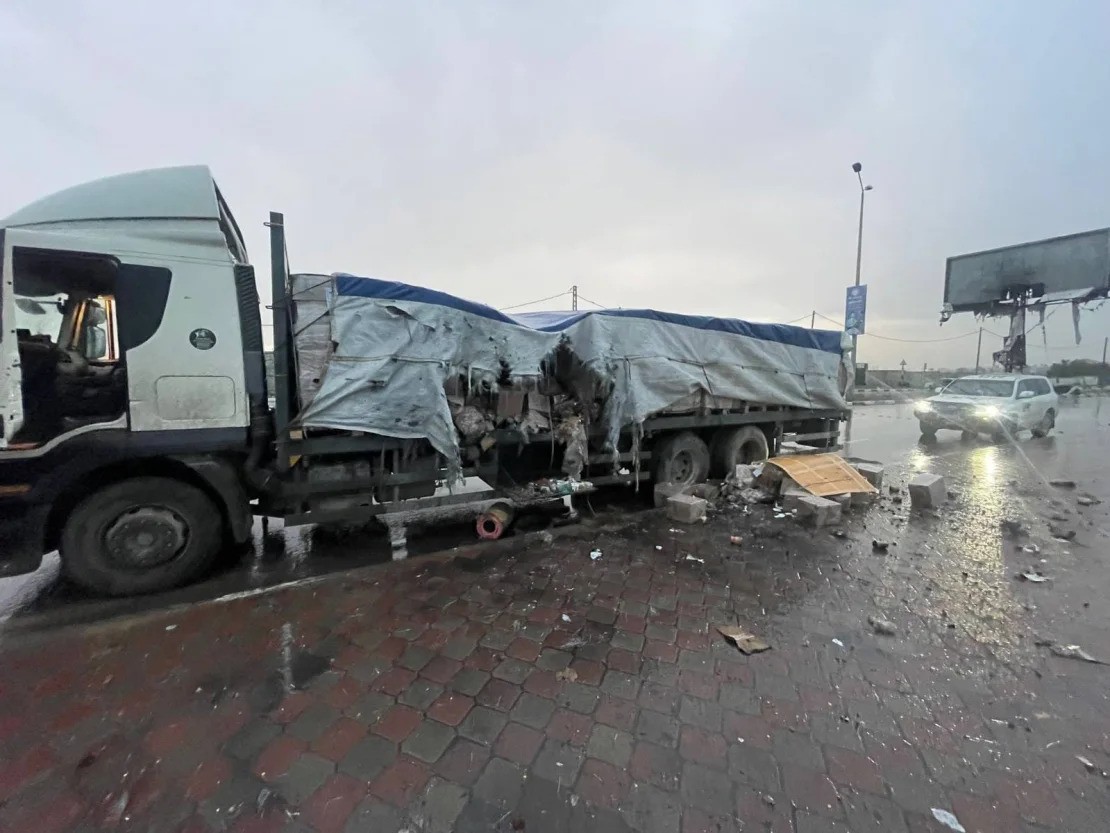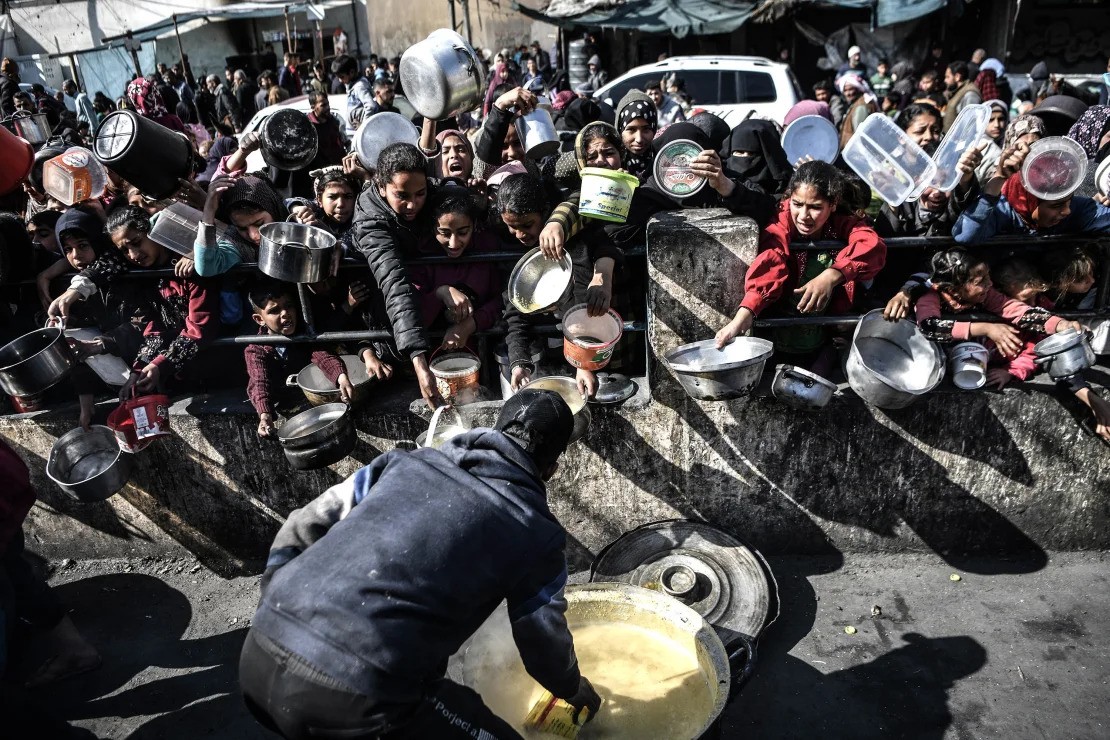Israeli Forces Open Fire On Food Convoy As It Issues A New Evacuation Order In Northern Gaza
Israeli forces open fire on food convoy as it issues a new evacuation order in Northern Gaza. Exclusive documents shared by the UN, reveal this incident.
Author:Paula M. GrahamReviewer:Hajra ShannonFeb 21, 20242.5K Shares75.5K Views

Israeli forces open fire on food convoy as it issues a new evacuation order in Northern Gaza. Israeli forces opened fire on the United Nations convoy transporting crucial food supplies in central Gaza on February 5th. Subsequently, they prevented the trucks from reaching the northern part of the territory, where Palestinians are facing an imminent famine. Exclusive documents shared by the UN, reveal this incident.
Correspondence between the UN and the Israeli military, viewed by reporters, confirms that both parties agreed upon the convoy's route before the attack. An internal incident report from UNRWA, Gaza's main UN relief agency, also obtained by reporters, indicates that one of the ten trucks in the convoy was stationary at an IDF holding point when it was fired upon.
Fortunately, no one in the convoy was injured, but a significant portion of its cargo – primarily wheat flour crucial for bread production - was destroyed. This incident sheds light on the considerable obstacles humanitarian efforts encounter in delivering aid to Gaza's over 2 million inhabitants, the majority of whom are internally displaced, amidst Israel's nearly five-month-long bombardment of the strip.
“„A convoy that had food on it, heading to the northern parts of the Gaza Strip. That convoy on its way in what we call the middle areas, it got hit. One of the trucks carrying supplies was hit by Israeli naval fire.- Juliette Touma, global director of communications for UNRWA
The Israel Defense Forces (IDF) has yet to comment on the strike, despite repeated requests. The IDF mentioned on February 5 that they are investigating the incident. This strike added to a series of attacks on aid convoys and warehouses providing humanitarian assistance since the conflict began.
Following Hamas' terrorist attack on October 7, Israel initiated airstrikes and a ground invasion of the Gaza Strip. The attack claimed the lives of at least 1,200 people, with over 250 others taken hostage. According to Gaza's Ministry of Health, Israeli attacks have resulted in the deaths of more than 29,000 individuals in the strip.
Following the strike on February 5, UNRWA decided to halt the dispatch of convoys to northern Gaza. The last time the agency managed to deliver food north of Wadi Gaza - a stretch of wetlands dividing the enclave - was on January 23. Approximately 300,000 people are still residing in northern Gaza, receiving minimal assistance. The UN has reported that acute malnutrition affects 16.2% of children in the area, surpassing the critical threshold.
The convoy, comprising 10 aid trucks and two armored vehicles bearing UN markings, commenced its journey in the early hours of February 5. UNRWA stated that these journeys are scheduled for the early hours to mitigate the risk of the convoy's contents being looted by those in desperate need of food along the way.
Departing from the southern part of Gaza, the convoy traveled along Al Rashid Road, which runs along the coastal edge of the strip. Since January, this road has been the primary route permitted by the Israeli military for humanitarian convoys and evacuations.
According to an internal incident report from UNRWA, the convoy reached a designated IDF holding point on Al Rashid Road at 4:15 a.m. There, the trucks remained stationary for over an hour. At 5:35 a.m., naval gunfire was reported, resulting in one of the trucks being hit.
UNRWA stated that before the aid delivery mission, coordination had been conducted with the Israeli military to agree upon the route, as is customary. Additionally, email correspondence between UNRWA and COGAT, the Israeli military agency overseeing activities in the Palestinian territories, confirms an agreement for the convoy to utilize Al Rashid Road.
"We share with the Israeli army the coordinates of the convoys, and the route of that convoy," Touma said. "Only when the Israeli army gives us the okay, the green light, does UNRWA move. We don’t move without that coordination."
She explained that the purpose of this coordination, known as the deconfliction process, is to prevent aid convoys from being targeted.
"Gaza has become very fast one of the most dangerous places to be an aid worker in," Touma said. "It is an extremely complex environment to operate in. Quite often our teams are forced to deliver humanitarian assistance under fire."
Evacuations In Northern Gaza
On Tuesday, Israel's military instructed two neighborhoods in Gaza City to evacuate amid indications of hunger and increasing desperation in the northern part of the enclave. This comes as the focus of Israel's offensive has shifted towards the south.
The evacuations coincided with the World Food Program ceasing deliveries in the north on Tuesday, citing chaotic scenes where its teams encountered looting, hungry crowds, and gunfire in recent days.
While the most intense fighting and bombing have recently moved south to areas near Khan Younis and Rafah, Israel's military evacuation order on Tuesday for the Zaytoun and Turkoman neighborhoods of Gaza City suggests the possibility of further military action in the north.
The northern Gaza region has suffered extensive destruction from four months of bombardment, exacerbating the ongoing conflict between Israeli forces and Hamas fighters. This situation has severely impeded the delivery of aid to approximately 300,000 people still residing in the area, as warned by the United Nations, who are now at risk of starvation.
Due to safety concerns, the World Food Programme (W.F.P.) has halted its aid deliveries for the past three weeks. However, when attempts were made to resume deliveries on Sunday, aid workers encountered difficulties. Crowds of desperate individuals surrounded the initial convoy en route to Gaza City, with some attempting to climb onto the trucks. The situation escalated further on Monday, with another convoy facing chaos and violence, resulting in the looting of several trucks and the assault of a driver.
The W.F.P. emphasized the gravity of their decision to suspend deliveries, acknowledging that it could lead to more fatalities due to hunger among the affected population in northern Gaza.
"W.F.P. is deeply committed to urgently reaching desperate people across Gaza but the safety and security to deliver critical food aid - and for the people receiving it - must be ensured," the statement said.
The World Food Programme (W.F.P.) highlighted the "unprecedented levels of desperation" observed by its teams as evidence of Gaza's rapid descent into hunger. It referenced a U.N. report published on Monday which revealed a significant increase in acute malnutrition in the northern part of the enclave.
Initially targeted by Israel's military offensive, northern Gaza bore the brunt of the attacks. As Israeli forces advanced further into Gaza, civilians were urged to relocate southward for their safety.
Responding to these warnings, hundreds of thousands fled, with over half of Gaza's population now seeking refuge in Rafah, where they reside in makeshift accommodations and tents. Despite this mass exodus, widespread shortages of food and water, along with persistent safety concerns, led some displaced individuals to return to the north.
Israel's military issued a new evacuation notice on Tuesday, instructing residents of two Gaza City neighborhoods to relocate to an area near the seaside village of Al-Mawasi, situated west of Khan Younis in the southern part of the enclave. Although the notice was posted in Arabic on social media, communication networks in Gaza have been heavily disrupted, making it uncertain how many people were able to view it.
Jump to

Paula M. Graham
Author

Hajra Shannon
Reviewer
Latest Articles
Popular Articles
